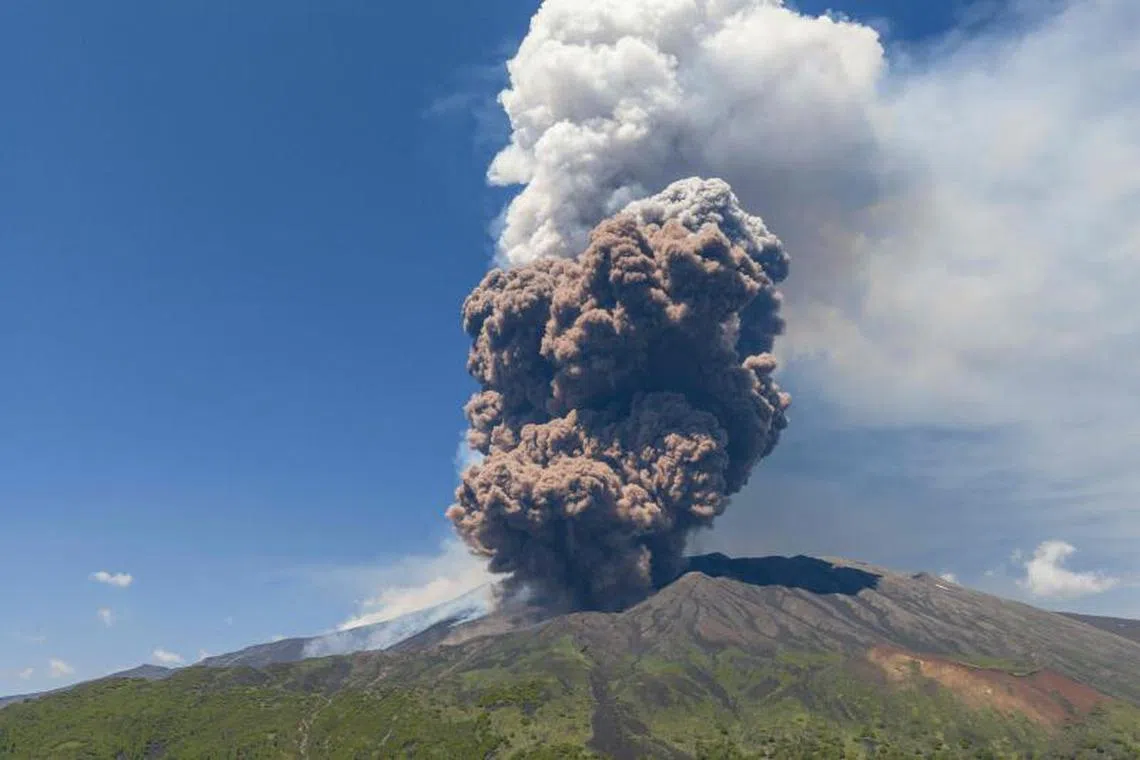Massive plume of ash, gas spews from Italy’s Mount Etna
Sign up now: Get ST's newsletters delivered to your inbox

The South-east Crater of Mount Etna near Catania, Sicily, generating an eruptive cloud on June 2 that went as high as 6.5km.
PHOTO: AFP
Follow topic:
ROME – A huge plume of ash, gas and rock spewed forth on June 2 from Italy’s Mount Etna, Europe’s largest active volcano, but the authorities said there was no current danger to the population.
Images showed a massive grey cloud billowing forth from the volcano on the island of Sicily, beginning at about 11.25am local time (5.25pm in Singapore), according to the National Institute of Geophysics and Volcanology (INGV).
Surveillance cameras showed “a pyroclastic flow probably produced by a collapse of material from the northern flank of the South-east Crater”, the agency said.
A pyroclastic flow occurs when volcanic rock, ash and hot gases surge from volcanos. They are extremely dangerous.
The explosive activity “had transitioned to a lava fountain”, INGV said, with the plume of ash expected to dissipate towards the south-west.
The president of the region of Sicily, Mr Renato Schifani, said experts had assured him there was “no danger for the population”, with the flow not having passed the Valley of the Lion, an area frequented by tourists.
Videos posted on social media appeared to show tourists hurrying down the side of the volcano, some taking photos, but AFP could not determine their authenticity.
“The partial collapse of the South-east Crater, which generated an impressive eruptive cloud several kilometers high and a pyroclastic flow, is a phenomenon that we follow with extreme caution,” Mr Schifani said.
Regional civil protection unit head Salvo Cocina recommended that tourists avoid the area “in consideration of the potential evolution of the phenomenon”.
A red alert issued for aviation authorities said the height of the volcanic cloud was estimated at 6.5km.
The nearby Catania airport was still in operation. However, more than 20 per cent of the flights arriving there were delayed, according to data from flight tracking site FlightAware.
As a popular tourist destination, Sicily welcomes millions of travelers annually, with more than 1 million visiting Mount Etna alone.
In recent years, authorities have struggled to control imprudent visitors who failed to appreciate the risks of getting a close look at the island’s most prominent landmark.
Mount Etna, a stratovolcano, or a conical volcano with relatively steep sides, shows almost continuous activity from its main craters and relatively frequent lava flows from craters and fissures along its sides. A previous major eruption had occurred in February.
Mr Charlie Camper and his wife Hannah, a couple from England, were vacationing at Villa Carlino House, which sits about 16km east of the volcano’s central crater, when volcanic plumes began billowing near the summit.
The couple was aware of previous eruptions but thought they would be “completely fine,” since “it’s active all the time,” Mrs Camper said in a WhatsApp message.
But she said they weren’t sure what to do if the activity worsened.
They did not receive any emergency messages on their phones, and after filming a video, ran inside and began searching the internet for safety warnings.
“We were waiting to hear something, but nothing came through even though the smoke was getting bigger and coming toward us,” she said. “At one point we could see the lava coming down the volcano.” AFP, NYTIMES

